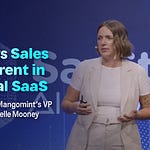Tomasz Tunguz of Theory Ventures brought together a strong panel at SaaStr Annual and AI Summit for a deep dive on enterprise partnerships. An Enterprise Partnerships Bootcamp: How to Land, Scale, and Win with Linear, Omni, Theory Ventures, and Vesey Ventures.
Christina Cordova – Chief Operating Officer at Linear, the purpose-built tool for planning and building products. Previously spent 7.5 years at Stripe where she started their partnerships organization, and later led partnerships and platform initiatives at Notion.
Colin Zima – CEO of Omni, rebuilding BI and analytics to create a tool accessible to both developers and end users with enterprise readiness and AI agility. Previously spent nearly 10 years at Looker, bringing deep data ecosystem expertise to his current venture.
Julia Huang – Founding Partner at Vesey Ventures, a fintech fund based in New York and Israel. Specializes in brokering partnerships between portfolio companies and financial incumbents, with deep expertise in enterprise sales motions within regulated industries.
Tomasz Tunguz – Founder and General Partner at Theory Ventures, focusing on early-stage enterprise software investments with particular emphasis on go-to-market strategy and partnership development.
Top Take-Aways:
Christina Cordova (Linear): Start with partnerships that are instrumental to your product experience first, not distribution. Build credibility by talking to 10+ users within an enterprise before approaching executives.
Colin Zima (Omni): Partner with companies at your growth stage rather than chasing Fortune 50 whales early. Strategic investments from key ecosystem players can bootstrap credibility faster than organic growth.
Julia Huang (Vesey Ventures): In enterprise partnerships, you’re controlling for reputational risk, not financial loss. Find the sponsor who can tell your story back to you—they’re your true advocate.
Tomasz Tunguz (Theory Ventures): The cost of building integrations has become trivial with AI. Companies should have 25-100 integrations by Series A, not 5-10 like in the past decade.
The Partnership vs. Sales Decision: Where to Start and Why
The fundamental question facing early-stage B2B companies isn’t whether to pursue partnerships or direct sales—it’s understanding when partnerships become instrumental to your product experience and business growth. Linear’s approach exemplifies this strategic thinking.
“For us on the partnership side, we really started with partnerships that we felt were instrumental to the product experience first and foremost,” explains Christina Cordova. “At a certain point we were a very small company. We viewed some integrations as hyper-critical to the core product—things like integrations with Slack and GitHub.”
Quotable Moment – Christina Cordova: “We were able to have 10 conversations for a very large account and then we go back to the CTO and say, ‘Actually, we’ve talked to 10 people on your team and here’s what they say about the products that you’re using today.’ And then they’re kind of like, ‘Oh, you know more about my team and my org than I do.’”
This product-first approach to partnerships reveals a crucial insight: the most successful early partnerships aren’t just distribution plays—they’re core to delivering your value proposition. Linear recognized that without seamless integrations to the developer tool stack, their product experience would be fundamentally incomplete.
The Evolution of Partnership Strategy: From Product to Platform
Omni’s partnership evolution illustrates how dependency relationships in the enterprise ecosystem have fundamentally shifted over the past decade. Colin Zema’s perspective, shaped by his experience building partnerships at both Looker and Omni, reveals how the technology stack has matured.
“We can’t deliver our product without a whole bunch of other products tightly coupled to us,” Zema notes. “We need to get data into a database. We need a database to run the queries and then we need to present them out to the user. At every level to be successful, we have these contingencies on these other tools and they need to want to work with us also.”
Quotable Moment – Colin Zema: “I can go call all of you in the audience and ask you to come try my tool. It’s a lot more successful if Snowflake is doing that alongside us and if DataBricks is doing that alongside us.”
But the partnership landscape has evolved dramatically. When Looker was scaling, companies often had to sell both ETL solutions and their core product to be successful. Today, that infrastructure is assumed. “Everyone sets up a database, buys a database, sets up Fivetran, and now how we partner with them is more important than whether they exist,” Zema explains.
This shift has profound implications for partnership strategy. Modern partnerships are less about filling infrastructure gaps and more about creating seamless experiences within established ecosystems.
The Credibility Framework: Building Trust at Enterprise Scale
Establishing credibility emerges as the central challenge—and opportunity—in enterprise partnerships. Julia Huang’s experience working with financial incumbents provides a masterclass in managing reputational risk.
“The risk that we were controlling for isn’t financial loss. It was reputational risk,” Huang explains. “If their reputational brand and image gets tarnished, then they don’t have the ability to sell their customers anything else.”
Quotable Moment – Julia Huang: “My practical advice on finding your sponsor is the person who can tell your story back to you in that meeting. Somebody who’s starting to get it—the wheels are turning. That person will at a minimum give you feedback, the true feedback of where you sit within the product and how long it’s going to take.”
This insight fundamentally changes how startups should approach enterprise partnerships. Success isn’t just about proving product-market fit—it’s about demonstrating that your company can enhance, rather than threaten, your partner’s reputation with their customers.
The credibility challenge manifests differently across organizational levels. When selling to individual contributors, you’re proving quarterly value. When selling to VPs, you’re demonstrating annual impact. When engaging C-level executives, you’re articulating a three-year vision that aligns with their strategic objectives.
The API-First Partnership Playbook
Linear’s approach to building their partnership ecosystem offers a replicable framework for developer-focused products. They started with a GraphQL API and “shipped the API and didn’t do a whole lot after that to bring on partners outside of just having really good technology.”
This hands-off approach generated over 150 integrations organically. But Linear’s strategy evolved with market conditions, particularly around AI partnerships. “More recently, we’ve thought more about partnerships in the context of AI in particular because it’s such a fast-moving space,” Cordova explains. “There we’re going much more the partnership route where we’re going to all the companies and spending time with those companies.”
The strategic shift reveals when to move from passive platform provision to active partnership development: when the technology landscape is moving so quickly that organic adoption can’t keep pace with market opportunities.
Strategic Investment as Partnership Accelerant
The relationship between strategic investment and partnership success has become increasingly important. Omni’s experience securing investment from both Snowflake and DataBricks illustrates how financial alignment can accelerate go-to-market execution.
“Both of those in isolation have been huge legitimizers for us as a company,” Zema notes. “It gives us opportunity to build more product over time and lets us bootstrap credibility with our customer base.”
But the investment decision requires careful consideration. “We’re way more concentrated in terms of our partnership,” Zema explains. “The databases are the most important to us. So it’s Snowflake, BigQuery, RedShift, DataBricks… We can’t move the needle for Snowflake’s earnings, but Looker did. And so we want them to trace that curve out and see that forward.”
The Timing Revolution: When to Hire Your First BD Person
Traditional wisdom suggested waiting until $5-10M ARR before engaging seriously in partnerships. Tomasz Tunguz challenges this conventional thinking: “I think that’s really changed. One of the earliest employees at Looker, Kenan was BD. He was responsible for 10 to 15% of bookings from the very first.”
The catalyst for this change? Technology has dramatically reduced integration costs. “The cost to produce an integration, an API integration, is really trivial,” Tunguz explains. “One of our companies had a hack day where in 90 minutes an engineer spun up an integrations factory.”
Quotable Moment – Tomasz Tunguz: “You kind of expect as a Series A investor a company having 25, 50, maybe even 100 integrations by the time of the Series A because it’s so simple. Whereas 10 years ago, that would be almost unimaginable because the engineering work required to do that would have taken years or hundreds of thousands of person-hours.”
This technological shift means companies can now reasonably be expected to have 25, 50, maybe even 100 integrations by Series A—a scale that would have been unimaginable a decade ago.
Christina’s hiring philosophy provides practical guidance: “When you’ve tested it with your current team, what are the kinds of partnerships, what do they look like? Once you know you want to do more of these and it’s going to be really a full-time job, then it makes sense to hire someone to do these in a dedicated fashion.”
Channel Strategy: Bottom-Up vs. Top-Down Approaches
The choice between bottom-up and top-down partnership approaches depends fundamentally on your product’s natural adoption pattern. Products that win on user experience often benefit from grassroots adoption, while products that solve C-level problems may require executive-first approaches.
Linear’s bottom-up strategy leverages product enthusiasm to build executive credibility. “We’re able to have 10 conversations for a very large account and then we go back to the CTO and say, ‘Actually, we’ve talked to 10 people on your team and here’s what they say about the products that you’re using today,’” Cordova explains.
This approach works because it builds internal advocacy before asking for budget authority. The CTO realizes, “You know more about my team and my org than I do,” creating credibility that transcends traditional sales processes.
The Enterprise Breakthrough: Acquisition-Driven Expansion
Some of the most successful enterprise partnerships emerge through acquisition scenarios. Both Linear and Omni have experienced rapid expansion when their startup customers get acquired by larger enterprises.
“We started off with this company of like 50 people. It was ultimately acquired by a Fortune 20 company and that Fortune 20 company started using us,” Cordova shares. “We were able to take that one customer and expand it to like a 500 seat account very quickly.”
This pattern reveals a crucial insight: startup CEOs often retain significant influence post-acquisition and can advocate for tools they’ve grown to depend on. It’s a channel strategy that requires no additional sales effort—just product excellence that creates passionate advocates.
The AI Partnership Acceleration
The current AI wave has created new urgency around partnership development. Both Linear and Omni are adapting their partnership strategies to capture AI-driven opportunities.
Linear is building new APIs specifically for AI agents and taking a much more proactive approach with AI partnerships. “There’s now this weird discretionary pool of cash that people can use for tools if you check the AI box,” Cordova notes.
This budget reality means partnerships that can credibly position AI capabilities have accelerated paths to enterprise adoption. The challenge is ensuring the AI positioning represents genuine value rather than checkbox marketing.
Measuring Partnership Success: Beyond Revenue Attribution
Traditional partnership metrics often focus on directly attributable revenue, but the most successful partnerships create value that’s difficult to measure directly. Brand credibility, ecosystem positioning, and customer trust building may be more valuable than immediate revenue in early-stage partnerships.
Colin’s experience illustrates this: “It’s a lot more successful if Snowflake is doing that alongside us and if DataBricks is doing that alongside us.” The value isn’t just in the leads generated—it’s in the credibility transfer that happens when established players validate your solution.
The Partnership Portfolio Strategy
As companies scale, partnership strategy must become more portfolio-driven. Not every partnership will generate immediate results, but a balanced approach can create multiple paths to success.
“I think as long as you place the right ones, it can be very fruitful,” Cordova explains about Linear’s approach to partnering with both established AI companies and emerging startups. “Some of those bets aren’t going to work out, but I think as long as you place the right ones, it can be very fruitful.”
This portfolio thinking requires discipline about resource allocation and clear criteria for partnership investment levels.
The Procurement Reality Check
Enterprise partnerships ultimately face the procurement reality of large organizations. Colin’s experience provides sobering perspective: “You realize that the conversations are actually completely different. The person may not have any idea what your company does. They have no ability to buy.”
This reality requires partnership professionals to develop multiple messaging frameworks for different organizational levels and decision-making authorities. The technical value proposition that resonates with practitioners may be irrelevant to budget holders focused on strategic outcomes.
Building Partnership Infrastructure for Scale
Successful partnership programs require infrastructure that can scale beyond individual relationships. APIs, documentation, partner portals, and co-marketing resources become essential as partnership volume increases.
Linear’s evolution from building individual integrations to providing platform capabilities illustrates this maturation. The infrastructure investment pays dividends when partners can self-serve many of their integration needs.
The Strategic Investment Decision Framework
When considering strategic investments from partners, companies must balance accelerated credibility against potential constraints on future partnerships. The decision requires careful analysis of how strategic alignment affects future partnership optionality.
Omni’s concentrated approach—focusing strategic investment on their most critical database partners—provides a model for how to think about these tradeoffs. “You can’t do a hundred of them either,” Zema notes.
Top Mistakes the Speakers Made (And What We Can Learn)
Christina Cordova’s Mistake: Being too hesitant to hire dedicated BD resources. “I’m always very hesitant to make that hire because I’ve seen it so many times how it can so easily go wrong.” While caution is warranted, this conservative approach may have delayed partnership scaling at Linear compared to more aggressive competitors.
Colin Zima’s Mistake: Admitting to poor executive communication. “I did a conversation last week with a CIO of a Fortune 50 and at the end he was pretty much like I had no idea what you were talking about.” This reveals insufficient preparation for senior-level conversations and highlights the critical importance of adapting technical messaging for different audiences.
Julia Huang’s Mistake: Allowing strategic partnerships to drag on too long without clear milestones. She describes partnerships with banks that “take years to come into fruition” and mentions going through reorgs “three times or four times” during one strategic partnership. Better partnership governance and clearer exit criteria could prevent resource drain.
Tomasz Tunguz’s Mistake: Overestimating the speed of integration development. While he correctly identifies that integration costs have dropped dramatically, his “90 minutes” integration factory example may set unrealistic expectations for quality, scalable integrations that require proper testing, documentation, and ongoing maintenance.








